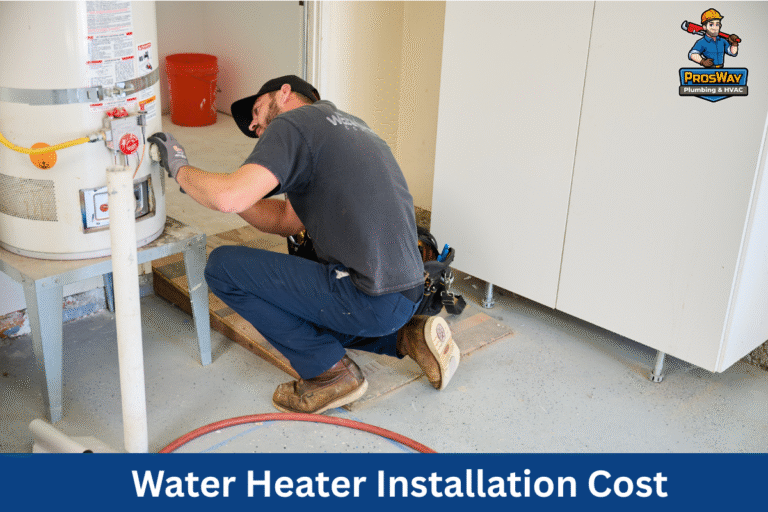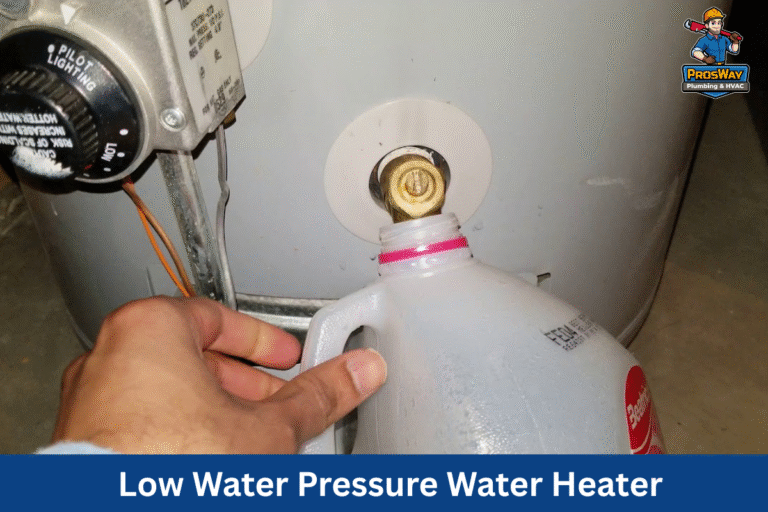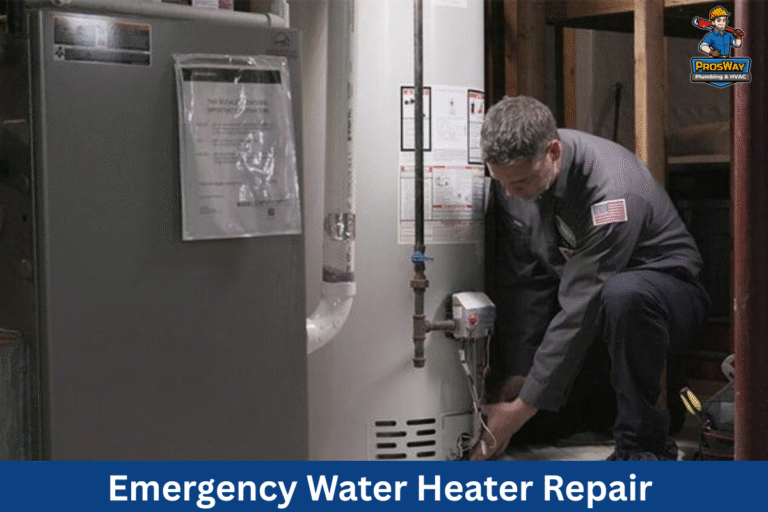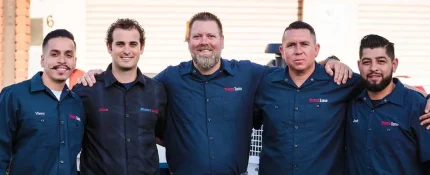A tankless water heater is built for reliability, but even the best systems can develop leaks. The good news? Tankless water heater leaking have clear causes and simple solutions when addressed quickly. For homeowners, understanding what a leak means and how to act fast can save time, money, and stress. And with trusted experts like Prosway Plumbing & HVAC, you’re never on your own.
This guide covers the most common reasons a tankless hot water heater leaks, the steps you should take immediately, and how to keep your system running safely for years.
Why a Leaking Tankless Water Heater Is a Serious Problem?
A tankless water heater leak might seem small at first, a drip from a fitting or a trickle near the condensate line. But even a slow leak can lead to:
- Water damage to walls, floors, and nearby appliances.
- Mineral buildup and corrosion damage shorten the heater’s lifespan.
- Safety hazards, including burns, electrical shorts, or mold growth.
Unlike storage tank heaters, tankless units don’t hold large amounts of water. Still, leaks indicate that something isn’t right, even if it’s a loose pipe joint, a faulty pressure relief valve, or a corroded heat exchanger. Addressing the issue quickly keeps repair costs lower and prevents the problem from escalating.
Main Causes of a Tankless Water Heater Leak
Here are the common causes behind a leaking tankless water heater:
Loose or Faulty Connections
Many leaks trace back to the inlet and outlet pipe fittings. Over time, constant heating and cooling cycles can loosen pipe joints or weaken seals. In some cases, improper water heater installation causes fittings to disconnect under pressure.
Tightening connections or replacing worn seals may stop the drip. But if you notice repeated leaks, a professional should inspect the water supply lines and pipe fittings for deeper issues.
Internal Corrosion
Hard water is common in New Jersey, and without treatment, it deposits minerals inside the system. Over time, this buildup damages the heat exchanger, leading to pinhole leaks and reduced efficiency.
Signs of corrosion include:
- Rust-colored water from faucets.
- Reduced hot water output.
- Visible rust stains near the heater.
Once corrosion compromises the heat exchanger, replacement is usually the only option.
Pressure Relief Valve Issues
The pressure relief valve (PRV) is a safety component that prevents excess pressure from damaging your unit. It may drip constantly or leak under stress if it fails.
Sometimes, the leak is caused by excess water pressure in the mainline. City codes limit supply to 80 PSI, but many homes run higher. Installing a pressure regulator and expansion tank helps maintain safe operating levels between 50–60 PSI.
Condensation
A condensing tankless water heater often produces condensation during operation. Light dripping from the condensate line may be normal. The key is distinguishing between harmless condensation and a true leak.
- Normal condensation: small drips during heating, usually clear water.
- Leak warning: puddles forming on the floor, especially if the water feels warm.
Since condensate is acidic, it should run through a condensate neutralizer to avoid pipe damage.
Clogged or Damaged Venting
Improper or clogged venting traps moisture, which can mimic a leak. In worst cases, it causes dangerous exhaust gases to back up. Call a technician immediately to check for blockages and ensure safe operation if you see moisture near the vent.
Manufacturer Defects or Aging Unit
Sometimes, the problem lies in the system itself. A leaking tankless water heater that’s more than 10 years old may simply be past its service life. Defective heat exchangers or weak seals in new models can also cause early leaks. If under warranty, water heater repairs or replacement may be covered.
Common Signs Your Tankless Water Heater Is Leaking

Spotting a leak early can save you from major damage. Some signs are obvious, while others are easily overlooked. Keep an eye out for:
- Visible puddles under or near the unit. Even small floor puddles signal that water is escaping where it shouldn’t.
- Dripping pipes or fittings at the inlet and outlet connections. Moisture around these joints often means they’re loose or worn.
- Low water pressure at faucets and showers, which may happen if water is escaping before reaching your fixtures.
- Error codes flashing on the digital panel. Many modern tankless systems detect internal leaks or pressure problems and display alerts.
- Rust stains or discoloration near the fittings or mounting area. This points to slow, ongoing leaks that corrode the surrounding metal.
What to Do if Your Tankless Water Heater Is Leaking
When you notice a leak from your tankless water heater, time matters. Even a small drip can turn into significant water damage if left unchecked. Acting quickly reduces safety risks and helps limit repair costs. Here’s a step-by-step approach:
1. Shut Off the Water Supply
Locate the cold water inlet valve above the unit and turn it clockwise to stop water from entering the heater. This step immediately halts further leaking and prevents puddles from growing. You may need to close the main shutoff valve for the house if you can’t find the inlet valve.
2. Cut Power to the Unit
- Electric models: Go to your electrical panel and flip the circuit breaker connected to the heater.
- Gas models: Close the gas shutoff valve located near the heater.
This prevents electrical hazards and reduces the risk of gas leaks or fire. Never attempt to work on the unit while power or gas is still running.
3. Contain the Water
Place towels, a bucket, or a shallow pan under the unit to catch dripping water. If the leak is steady, consider attaching a garden hose to the drain valve (if applicable) to channel water safely to a floor drain. This step won’t fix the issue, but it will protect floors and surrounding structures until a plumber arrives.
4. Avoid Internal DIY Repairs
It’s tempting to remove panels or try sealing leaks yourself, but tankless water heaters are complex. Components like the heat exchanger, pressure relief valve (PRV), and condensate line are sensitive. Opening the system without proper tools or training can:
- Void your warranty.
- Worsen leaks or damage the internal shell.
- Create safety risks, including burns from hot water or gas hazards.
Instead, limit your actions to containment and shutoff steps, then call a licensed plumber for inspection.
DIY Troubleshooting vs. Professional Repairs

Some small checks are safe for homeowners. Others require a licensed plumber.
- Safe homeowner checks:
- Tighten loose fittings with a wrench.
- Inspect hoses and visible joints for dripping.
- Check the pressure gauge on an outside spigot to see if the water pressure is above 80 psi.
- Tighten loose fittings with a wrench.
- Call a professional when:
- Water continues leaking after tightening fittings.
- The pressure relief valve drips constantly.
- Water continues leaking after tightening fittings.
- You see corrosion damage on the heat exchanger.
- Error codes indicate an internal fault.
Ignoring a leak can worsen the problem. High water pressure, mineral buildup, or corroded pipes don’t resolve on their own. Waiting too long risks expensive repairs or a full replacement.
Preventing Future Tankless Water Heater Leaks
- Annual Inspections: Have a plumber check the PRV, pipe joints, and venting once a year to catch early wear.
- Flush the System:
- 1x per year for normal water.
- 2x per year in very hard water areas.
- Consider a water softener to protect the heat exchanger.
- 1x per year for normal water.
- Check Venting & Condensate Lines: Ensure condensate from condensing units drains properly through a neutralizer.
- Control Water Pressure:
- Keep below 80 PSI (ideal range: 50–60 PSI).
- Install a pressure regulator and expansion tank to manage thermal expansion.
- Keep below 80 PSI (ideal range: 50–60 PSI).
Routine care prevents mineral damage, excess pressure stress, and costly leaks.
Final Thoughts
A leaking tankless water heater doesn’t always mean a replacement is necessary. Sometimes it’s a loose-fitting or excess pressure that can be corrected. But fast action is key; shutting off water, cutting power, and calling a professional keeps you safe and prevents costly damage.
Call Prosway Plumbing & HVAC Today!
Don’t wait for a small drip to become a flood. Call us now at (862) 260-5870 or Book Online for same-day service, expert leak diagnosis, and reliable repairs, so you can get back to hot water without the stress.









